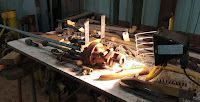Let's see, who else am I missing? Norm was working on the overload relay for the 306 again. Joel was there along with several of the younger members whom I don't know because I've mostly been coming out on weekdays, hard at work on various projects. And there were others who were there for the car cleaning session. You just have to be there in person to see it all.
News and views of progress at the Illinois Railway Museum
Sunday, April 30, 2023
Doors to Progress
Let's see, who else am I missing? Norm was working on the overload relay for the 306 again. Joel was there along with several of the younger members whom I don't know because I've mostly been coming out on weekdays, hard at work on various projects. And there were others who were there for the car cleaning session. You just have to be there in person to see it all.
Posted by
Randall Hicks
at
9:00 AM
0
comments
![]()
Thursday, April 27, 2023
Thursday Progress
And here's the first one with its piping and newly-fabricated support brackets out in the barn.
Posted by
Randall Hicks
at
9:12 PM
0
comments
![]()
Wednesday, April 26, 2023
Early Chicago Streetcars from the Bill Wulfert Collection
Thanks to Bill Wulfert for providing these fascinating images from the early days of Chicago streetcars. These photos are copyright Bill Wulfert and may not be copied or reproduced.
Posted by
Frank Hicks
at
5:15 PM
0
comments
![]()
Labels: Bill Wulfert Photos
Tuesday, April 25, 2023
Monday Report
On Monday, I started by unloading the first of the seats I got from MCRM into storage, and spent some time rearranging things. Then it was time to go to the car shop and see what's happening.
We'll start with the 306. Here's the nice new floor at the west end of the car. Phil the new guy did most or all of the work on this.
Posted by
Randall Hicks
at
10:02 AM
0
comments
![]()
Monday, April 24, 2023
Visit to North Freedom
On Friday and Saturday I went up to North Freedom to help some friends of mine at Mid-Continent, Bill Buhrmaster and Pete Becker, acting as a consultant on canvas roofs. Nice work if you can get it -- all I have to do is point out what needs to be done, and they get to do the hard stuff. This side of the roof is already done, and looks quite good. (And I'm always glad to see that my students are taking good notes!)
Posted by
Randall Hicks
at
3:00 PM
2
comments
![]()























































